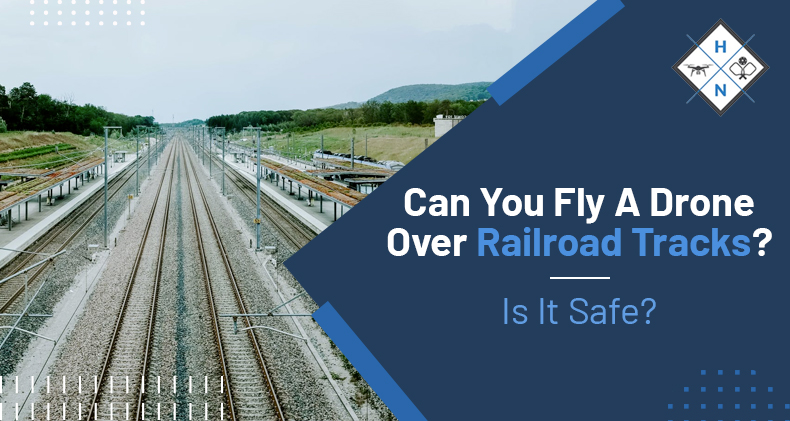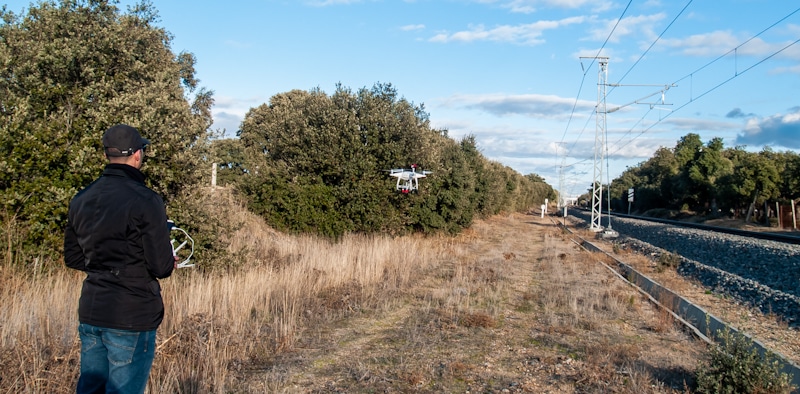Some rules guide the operation of an unmanned aerial vehicle (UAV), commonly referred to as drones. The Federal Aviation Administration (FAA) is charged with the enforcement of the rules. As a drone pilot, you need to know and understand these rules before flying your drone.
No, you cannot fly a drone over railroad tracks. Railroads are now classified as critical infrastructures, so flying a drone over rail tracks is considered illegal. Although not all states in the USA consider railroad tracks as critical infrastructure, is advisable to stay clear of railroad tracks.
Now you know that you must not fly a drone over a railroad track, but you still need to understand the regulations enforced by the Federal Aviation Administration (FAA) before flying your drone. This is to ensure you are not breaking the laws.
The Federal Aviation Administration (FAA) And Drone Flying
The regulation of the airspace is designated to the Federal Aviation Administration or the FAA. This also includes the regulation of drone flying, either for recreational or commercial purposes. The FAA creates the laws for regulating flight in the airspace of the United States of America.
The airspace refers to the air available for aircraft to fly in, and it is subject to the jurisdiction of a particular country. The airspace has two categories, the "Uncontrolled Airspace," this is the airspace 400 feet from the ground. The other category is the "Controlled Airspace," the airspace above 400 feet from the ground.
The controlled airspace is regulated by the Federal Aviation Administration, while the uncontrolled airspace as the name implies is not regulated, but different states and areas have regulations that control the uncontrolled airspace.
Below are some of the rules enforced by the FAA to regulate the recreational flying of drones.
- While flying a drone, you need to maintain a visual line of sight. This means you must not fly your drone out of your sight.
- Once your drone is registered for recreational purposes, you cannot use it for commercial jobs.
- It is illegal to fly a drone without adequate lighting at night.
- Your drone must be registered with the FAA before you can fly it.
- Unless your drone has been certified by a community-based organization, it must not weigh more than 55 pounds.
- You must not fly your drone above or near emergency activities and critical infrastructures, including transport systems (vehicles, airports, seaports, and railroad tracks).
The laws regulating the commercial flying of drones are similar to the ones regulating recreational flying. The laws that are strictly for commercial flying of drones are.
- An FAA-issued Remote Pilot Certificate is required before you can fly your drone commercially.
- The speed at which you fly your drone must not exceed 100 mph.
- You can only fly your drone in the Class G airspace.
- Except you are in a sparsely populated area, you must not fly your drone from a moving vehicle.
Is It Safe To Fly A Drone Over A Railroad Track?
With the latest forecast by the Federal Aviation Administration that over nine hundred thousand unmanned aerial vehicles (UAV), or unmanned aircraft systems (UAS), or drones have been registered with the FAA. There has been a massive increase in the use of drones for both commercial and recreational use.
While lots of industries and major sectors are now integrating the use of drones into their operations after realizing the potential benefits, there are also some security risks and hazards posed by drones. Drones can cause lots of damages, especially to critical infrastructures, like railroad tracks.
It is not safe to fly a drone over a railroad track or even beside a railyard; there are possibilities of it interfering with train operations and industrial espionage.
Although Congress has passed laws to offer protections to critical infrastructures, the U.S. Department of Homeland Security and the U.S. Department of Transportation has been slow in the implementation of these laws.
So, railroad companies are considering an alternate solution, to develop technologies that will restrict the use of drones near their operations. And this is to ensure the safety of their passengers and workers.
Different states in the United States also have laws that offer protection to railroad facilities, and almost all states have amended and passed laws that regulate the operations of drones near railroad facilities.
Some states like Oregon, Oklahoma, Delaware, and Texas have passed laws that prohibit the flying of drones near or over critical infrastructures, including railroad facilities. So, if you are in any of the states mentioned, you are committing a crime by flying your drone over a railroad track, a train, or even near any railroad facility.
Railroad companies now make use of drones to inspect vital aspects of rail infrastructures, like switching points and track alignment, as well as railway catenary lines. You will be interfering with the railroad company's operations by flying your drone alongside.
Drone Laws Violations That Could Make You End Up In Jail
There are lots of offenses you can commit that will make you get locked up in jail. Many people do not know that by violating a drone law, they can end up in jail. These are some of the violations that can make you end up in jail in the United States.
Using A Drone To Conduct Illegal Activities
You could get arrested for using a drone to carry out illegal activity. There was a situation where the police in Maryland arrested two people for trying to smuggle tobacco, pornography, and drugs into a correctional facility using a drone. If the law is against an activity, using a drone to carry out that activity is still an offense. So you should stick to flying your drones for only legal reasons.
Flying A Drone Near An Airfield or Airport
It is prohibited to fly a drone within a 5-mile radius from an airport without obtaining permission from the airport tower. The U.S. Federal Aviation Administration has enforced this law. And anyone found to be violating this law is at risk of being locked up. Flying a drone near an airport is a very serious offense because there are lots of consequences and dangerous repercussions that can result from it.
This also includes flying a drone in a no-fly zone. There are lots of locations where it is forbidden to fly a drone, and you can risk a jail sentence by violating this law. Different states in the United States have different no-fly zones.
Flying A Drone Too High
The limit you can fly your drone is below 400 feet from the ground. If you fly your drone beyond that specified limit, you can get arrested. The FAA regulates the controlled airspace, and that is where aircraft fly. By flying your drone at that height, you are endangering the lives of the passengers and the crew on an aircraft. If you remember, w stated earlier that your drone must always be in your visual line of sight, flying over 400 feet from the ground is breaking that regulation.
Flying A Drone Near An Emergency Activities
The United States has strict laws in place to deal with anyone that interferes with or restricts the operations of emergency workers. So, flying a drone near an emergency is a very grievous violation and can make you get a jail sentence. In June 2016, there was a forest fire in California, and firefighters were unable to deploy helicopters because drones were hovering over the forest. After this event, a law was passed that impeding emergency activities carries a fine of up to twenty-five thousand dollars.
Flying An Unregistered Drone
This is another violation with grave consequences. It is very important to register your drone with the Federal Aviation Administration before flying it. The fine for flying an unregistered drone is twenty-seven thousand dollars, and you could also get a three months jail sentence. The registration fee for a drone is just five dollars, a small token. Why risk the penalty when you could just evade it.
Importance of Geofencing in Drones
The Federal Aviation Administration does not expect you to know all the no-fly zones across the country, and there are variations across different states. Do not worry, there is a way to identify no-fly zones, and you can make sure your drone flight is completely legal.
Geofencing in drones is the technology developed that helps you avoid no-fly zones. The drones can identify no-fly zones and can avoid flying through or near them regardless of how hard you try.
There are mobile applications that enable geofencing in drones and some drones have geofencing added to their components. So, areas that are actively restricted are identified by the drones during flight and they cannot fly over them once identified.

Geofencing in drones is the best choice to avoid violating the laws that regulate where you can fly your drone to.
Final Thoughts
Claiming ignorance of the law is not an excuse in the court of law. So learning all the regulations that control the flying of drones is imminent. Before flying your drone, you need to sit down and go through the FAA and local drone laws in the area you are in.
You cannot fly your drone the way you do in Texas in California, there are different laws. Study them, and you have no limitations because you understand your boundaries.
Shawn Manaher loves to play with new toys and dive into new hobbies. As a serial entrepreneur, work definitely comes first but there is always room for hobbies.



